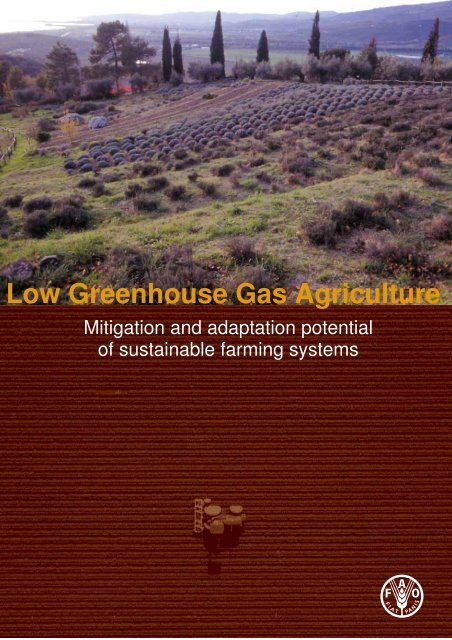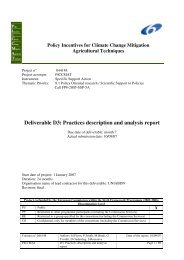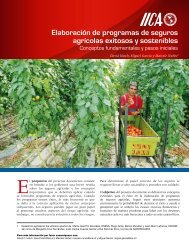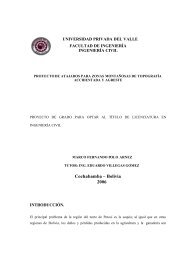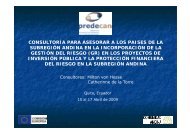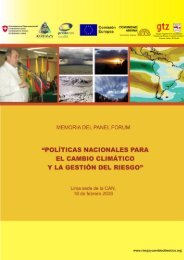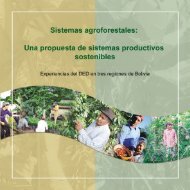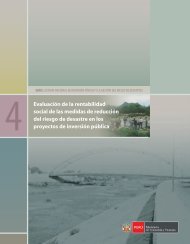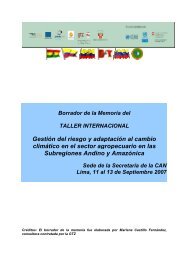Low Greenhouse Gas Agriculture - MAPAQ
Low Greenhouse Gas Agriculture - MAPAQ
Low Greenhouse Gas Agriculture - MAPAQ
- No tags were found...
You also want an ePaper? Increase the reach of your titles
YUMPU automatically turns print PDFs into web optimized ePapers that Google loves.
<strong>Low</strong> <strong>Greenhouse</strong> <strong>Gas</strong> <strong>Agriculture</strong>Mitigation and adaptation potentialof sustainable farming systems
LOW GREENHOUSE GAS AGRICULTURE:MITIGATION AND ADAPTATION POTENTIAL OFSUSTAINABLE FARMING SYSTEMSContentsIntroduction..........................................................................................................................2Mitigation options of agricultural practices and techniques..................................................2Crop rotations and farming system design.......................................................................2Nutrient and manure management...................................................................................3Livestock management, pasture and fodder supply improvement ...................................5Maintaining fertile soils and restoration of degraded land ................................................6The potential of ecologically managed farms to adapt to climate change............................9Farmer knowledge as a key to adaptation .......................................................................9Soil stability ......................................................................................................................9Biodiversity and adaptation to climate change ...............................................................10Conclusions .......................................................................................................................10References ........................................................................................................................11This document has been prepared by Urs Niggli and Andreas Fließbach ofthe Research Institute of Organic <strong>Agriculture</strong> (FiBL), Switzerland(www.fibl.org) and by Paul Hepperly, The Rodale Institute, USA(www.rodaleinstitute.org), in cooperation with Nadia Scialabba, NaturalResources Management and Environment Department, FAO(www.fao.org/organicag). The views expressed in this document are thoseof the authors and do not necessarily reflect the views of FAO.FAO, May 20081
INTRODUCTIONEach year, agriculture emits 10 to 12 percent of the global total of estimated greenhouse gas (GHG)emissions, some 5.1 to 6.1 Gt CO 2 equivalents per year. Smith, et al. (2007) and Bellarby, et al.(2008) have proposed mitigation options for GHG emissions that include: improved crop, grazing,livestock and manure management; conservation of organic soils; restoration of degraded lands; andthe use of agro-energy crops. These mitigation options challenge farmers and policy-makers tochange practices and, inter alia, to improve development of no-till cropping, agro-forestry andintegrated crop and animal farming, and to decrease use of external inputs in food and agriculture.Organic agriculture offers techniques which are valuable for consideration in further debates.This paper examines current farming practices and uses scientific data of mainly long- term fieldexperiments as case studies for low greenhouse gas agriculture. It also elucidates the adaptivecapacity of agro-ecological farming system approaches, using organic system case studies from thescientific literature.MITIGATION OPTIONS OF AGRICULTURAL PRACTICES ANDTECHNIQUESIn the Fourth Assessment Report of the Intergovernmental Panel on Climate Change (IPCC), Smith,et al. (2007) made important recommendations that illustrate the need for change in farmingpractices in relation to GHG issues. These are discussed below.Crop rotations and farming system designRecommendations of the IPCC Fourth Assessment Report:• improving crop varieties;• featuring perennials in crop rotations;• making greater use of temporary cover crops (between successive crops or between rows ofplantations);• avoiding bare fallows;• enhancing plant and animal productivity and efficiency;• adopting farming systems with reduced reliance on external inputs (e.g. rotations which includelegume crops).Intensive crop production - often based on monocultures and being highly productive - is also highlydependent on external inputs such as mineral fertilizers and pesticides. Sustainable agriculturalpractices, such as organic agriculture, strongly reduce the reliance on external inputs by:• recycling nutrients and using nitrogen-fixing plants;• improving cropping systems and landscapes in order to avoid synthetic pesticides and usingbiocontrol;• including animals as a farm production sector and including grass clover leys for fodderproduction, while avoiding purchase of feed concentrates.Nutrients for sustainable crop production are delivered by soil transformation being applied either asmanure or compost or fixed by leguminous plants. Nitrogen from legumes is more sustainable interms of ecological integrity, energy flows and food security than nitrogen (N) from industrialsources (Crews and People, 2004). These nutrients are partly biologically bound and have to be2
mineralized by soil biological processes. In order to avoid nutrient losses (since they are of limitedavailability in low-input systems), soils should be covered permanently by crops in an optimizedsequence. In organic and conventional agriculture, the inclusion of cover and catch crops is both atraditional and state-of-the-art practice (Thorup-Kristensen, 2007). Bare fallows are not onlyunproductive, they are more prone to nutrient loss and thus, for environmental and economic reasons,should be completely avoided.Productivity in sustainable agriculture, especially in organic agriculture, is enhanced by manyindirect measures based on improving soil fertility and stimulating the roles of plants and microbes innatural soil processes. These can be based on symbiotic and asymbiotic nitrogen fixation andexploiting soil Phosphorus and water resources by symbiotic mycorrhiza (Mäder, et al., 2000; 2002).The role of soil carbon is not only important for soil moisture, it contributes to counteractinggreenhouse gases. In this regard, mycorrhizal fungi are practically important. Intercropping andunder-sowing of legumes and integrating deep and shallow rooting crops provide another approachto increase productivity and nutrient efficiency internally. Finally, mixed farming or cooperativemodels between specialized farms are a basis for recycling animal faeces and diversifying productionsectors, especially due to crop and fodder diversity and grass-clover leys.The global potential of nitrogen availability through recycling and nitrogen fixation is far bigger thanthe current production of mineral nitrogen (Badgley, et al., 2007; Niggli, et al., 2007). On-farm useof farmyard manure (a practice increasingly abandoned in conventional production) needs to bereconsidered in the light of climate change. While conventional stockless arable farms becomedependent on the input of synthetic nitrogen fertilizers, manure and slurry from livestock farmsbecome an environmental problem. In these livestock operations, nutrients are available in excessand over fertilization may occur. Nutrient leaching leads to water pollution and high emissions ofcarbon dioxide (CO 2) , nitrous oxide (N 2 O) and methane (CH 4 ) are likely. Compost is particularlyuseful in stimulating optimized soil organic matter and at the same time reducing nutrient lossescompared to either raw manure or synthetic fertilizer.Nutrient and manure managementRecommendations of the IPCC Fourth Assessment Report:• improving nitrogen-use efficiency (reducing leaching and volatilization, reducing offsite N 2 Oemissions);• adjusting fertilizer application to crop needs (synchronization);• using slow-release fertilizers;• applying N when crop uptake is guaranteed;• placing N in soil to enhance accessibility;• avoiding any N-surplus applications;• managing tillage and residues;• reducing tillage or no-till.Crop productivity in intensive agriculture has increased substantially by high inputs of solublefertilizers and pesticides - mainly nitrogen. Under natural conditions, nitrogen is biologically boundand often limits production. Mineral nitrogen in soils may contribute to the emission of nitrousoxides and is one of the main drivers of agricultural emissions. The efficiency of fertilizer usedecreases with increasing fertilization, when a great part of it is not taken up by the plant but emittedinto the water bodies and the atmosphere. In summary, the emission of GHG in CO 2 equivalentsfrom the production and the application of nitrogen fertilizers from fossil fuel amounts atapproximately 480 million tonnes (1 percent of total global GHG emissions) in 2007. In 1960, 47years earlier, it was less than 100 million tonnes.3
Recycling nitrogen on the farm by using manure and nitrogen fixing plants (the predominanttechnique of organic and low external input agriculture) enhances soil quality and provides nutrients.However, timing and management of its use are essential, as soil mineralization processes shoulddeliver the elements to the plant at times of peak demand. Excess nitrogen is prone to leaching andgaseous emission. In addition, timing and management both are site specific and, thus, challengingfor farmers. As nitrogen on organic farms is far more costly than industrial nitrogen, there is anincentive to avoid losses (Stolze, et al., 2000).Certified farming systems limit the amount of fertilizer use (e.g. integrated farming) and/or livestocknumbers per area or purchase of fodder (e.g. organic agriculture), thus limiting the return of nitrogenand other elements to the soil. N-application rates in organic agriculture are usually 60 to 70 percentlower than in conventional agriculture because of the recycling of organic residues and manures. Inaddition, the limited availability of nitrogen in organic systems requires careful, efficientmanagement (Kramer, et al., 2006). Badgley, et al. (2007) calculated the potential nitrogenproduction by leguminous plants via intercropping and off-season cropping to be 154 million tonnes,a potential which far exceeds the nitrogen production from fossil fuel and which is not fullyexploited by current conventional farming techniques.Figure 1: Relative input and output of three farming systems: organic agriculture; integratedproduction with farmyard manure; and stockless integrated production. Input of nutrients, organicmatter, pesticides and energy as well as yields were calculated on the basis of 28 years. Cropsequence was potatoes, winter wheat followed by fodder intercrop, vegetables (soybean), winterwheat (maize), winter barley (grass-clover for fodder production, winter wheat), grass-clover forfodder production, grass-clover for fodder production. Crops in brackets are alterations in 1 of the4 crop rotations (Source: DOK field experiment in Switzerland, Mäder, et al., 2002)4
Mäder, et al. (2002) report an increased efficiency of organic agriculture for most arable crops, withgrain crops showing a yield reduction of only 20 percent while fertilizer inputs were lower by 50-60percent (see figure 1). Piementel, et al. (2005) report yields in organic maize and soybean that arecomparable to conventional maize and soybean production, indicating that depending on theenvironment, organic field crop production can be competitive with conventional farming even in ahigh-yield environment.In life cycle assessments, Nemecek, et al. (2005) showed that area-based GHG emissions in theorganic systems were 36 percent lower than in conventional systems. Per kg product, the GHGemissions were 18 percent lower, due to 22 percent lower dry matter yields (see Figure 1). Most ofthis difference is caused by CO 2 and N 2 O emissions - both of which are merely related to mineralfertilizer use in conventional farming.In organic agriculture, the ban of mineral nitrogen and the reduced livestock units per hectareconsiderably reduce the concentration of easily available mineral nitrogen in soils and thus, N 2 Oemissions. Furthermore, diversifying crop rotations with green manure improves soil structure anddiminishes N 2 O emissions. Soils managed organically are more aerated and have significantly lowermobile nitrogen concentrations, which also reduces N 2 O emissions. Mathieu, et al. (2006) point outthat higher soil carbon levels may lead to N 2 emission rather than N 2 O. Petersen, et al. (2006) foundlower emission rates for organic farming compared to conventional farming in five Europeancountries. In a long-term study in southern Germany, Flessa, et al. (2002) also found reduced N 2 Oemission rates in organic agriculture, although yield-related emissions were not reduced.A reduction of the Global Warming Potential (GWP) has also been found on Dutch organic dairyfarms and in organic peas production areas as compared to conventional (Bos, et al. 2006). Incontrast, the authors stated higher GHG emissions for organic vegetable crops (e.g. leek and potato).Organic potatoes, tomatoes, and other various vegetables (Öko-Institut, 2007) had less GHGemissions than the compared conventional crops. In contrast, higher emissions for organic cropswere modelled for the experimental farm in Scheyern (Bavaria), Germany, where organic andconventional farming systems were run on a split farm (Küstermann, et al. 2007). The authors alsocalculated the GHG emissions of 28 Bavarian commercial crop farms - organic and conventional -and found equal and, in some cases, slightly higher emissions for organic.These figures appear controversial, but they demonstrate how crucial it is to choose the right database, to apply the right model and to define system boundaries properly. When carbon sequestrationwas excluded from life cycle assessments on the Scheyern experimental farm, the GWP was53 percent higher in the organic system compared to conventional, but was 80 percent lower whencarbon sequestration was included (Küstermann, et al., 2007). In a study at Michigan StateUniversity, Robertson, et al. (2000) calculated the net GWP for organic crops to be 64 percent lowerthan conventional.Livestock management, pasture and fodder supply improvementRecommendations of the IPCC Fourth Assessment Report:• reducing lifetime emissions;• breeding dairy cattle for lifetime efficiency;• breeding and management to increase productivity;• implementing deep rooting species;• introducing legumes into grasslands (to enhance productivity);• preventing methane emissions from manure heaps and tanks;• producing biogas;• composting manure.5
Methane accounts for about 14 percent of all greenhouse gas emissions (Barker, et al., 2007). Twothirds of the methane emissions stem from enteric fermentation and manure management and, as aconsequence, are directly proportional to livestock numbers.On most organic farms, crop and livestock production are closely linked by traditional mixed farmsor by regional cooperation of specialized farms or farm branches. This leads to lower input ofnutrients by farmyard manure (FYM) on grassland and pastures as well as to fewer environmentalproblems such as run off of phosphorous, nitrogen leaching into deeper soil layers and emission ofN 2 O. Organic agriculture has an important, though not always superior, impact on the reduction ofN 2 0 as livestock numbers are limited (Weiske, et al., 2006; Olesen, et al., 2006).As a result of moderate fertilization, grassland and pastures tend to be more diverse on organicfarms. Species reaching different soil layers in order to exploit soil nutrients better are typical forgrassland on organic farms. Legumes are strongly promoted on organic grassland and pastures asthey provide both nitrogen into the soil and protein into the feedstuff.The data available on methane emissions from livestock is limited, especially with respect to thereduction of GHG emissions from ruminants and manure heaps. Some authors suggest high energyfeedstuff to reduce methane emissions from ruminants (Beauchemin and McGinn, 2005), but theruminants’ unique ability to digest roughage from pastures would then not be used. Furthermore,meat and milk would be produced with arable crops (concentrates) where mineral nitrogen is animportant CO 2 emitter, and competition to human nutrition may become a problem.Another positive difference between organic and conventional cattle husbandry is that organicbreeders aim at longevity (Kotschi and Müller-Sämann, 2004). The ratio between the unproductivephase of young cattle and the productive phase of dairy cows is favourable in organic systemsbecause, calculated on the basis of the total lifespan of organic dairy cows, less methane is emitted.On the other hand, lower milk yields of organic cows caused by a higher proportion of roughage inthe diet, might increase methane emissions per yield unit.Storage and composting of manure and organic waste have been strongly improved on organic farmsin recent years. These modern techniques (e.g. covering, processing compost and steering thecompost process) prevent leaching and reduce N 2 O emissions. Composting manure may reduce CH 4but enhance N 2 O emission from heaps. Compost use can greatly enhance carbon sequestration in thesoil compared to raw manure use.Biogas production from liquid slurry makes use of the evolving CH 4 for energy and is applied bymany sustainable farmers.Maintaining fertile soils and restoration of degraded landRecommendations of the IPCC Fourth Assessment Report:• initiating revegetation;• improving fertility by nutrient amendment;• applying substrates such as compost and manure;• halting soil erosion and carbon mineralization by soil conservation techniques such as reducedtillage, no tillage, contour farming, strip cropping and terracing;• retaining crop residues as covers;• conserving water;• sequestering C0 2 into the soil as soil organic matter.6
Variations of these recommendations are practiced through various techniques of organic agricultureand no-till agriculture. These include: improving soil fertility, applying substrates and retaining cropresidues (organic agriculture), halting soil erosion, conserving water and sequestering C0 2 (organicagriculture and no-till cropping). In long-term experiments, carbon sequestration rates varyconsiderably (see Table 1). In the DOK field experiment in Switzerland (Mäder, et al., 2002), thestockless conventional plots lost 207 kg carbon/ha/year during the first 28 years of the experiment,while the bio-dynamic plots remained stable in soil organic matter content (Fliessbach, et al., 2007).In the Rodale experiment in the USA (Pimentel, et al., 2005), the manure-based organic systemsequestered 1218 kg carbon per ha and year, the legume-based stockless organic system 857 kg, andthe conventional system 217 kg.Hülsbegen and Küstermann, et al. (2008) compared 18 organic and 10 conventional farms inBavaria, Germany, and calculated the organic farms annual sequestration at 402 kg carbon, while theconventional farms had losses of 202 kg (see Table 1). Hepperly, et al. (2008) estimated thatcompost application and cover crops in the rotation were particularly adept at increasing soil organicmatter, also compared to no tillage techniques (see Table 2).Table 1: Comparison of soil carbon gains and losses in different farmingsystems in long term field experimentsField trialComponents comparedCarbon gains (+) orlosses (-) kg ha -1 yr -1DOK experiment, CH Organic, FYM composted 42(Mäder, et al., 2006) Organic, FYM fresh -1231977 - 2005 IP, FYM, mineral fertilizer -84IP, mineral fertilizer -207SADP, USA, 1994-2002 Organic, no till 1 829(Teasdale, et al., 2007) Conventional, no till Rodale FST, USA Organic, FYM 1 218(Hepperly, et al., 2006; Organic, legume based 857Pimentel, et al., 2006) Conventional 217Bavarian farm survey 18 organic farms (average) 402(Hülsbergen and 10 conventional farms-202average)Küstermann, 2008) Frick reduced tillage Organic, ploughing 0experiment, 2002-2005 Organic, reduced tillage 879(Berner, et al.,submitted) <strong>Agriculture</strong> can help mitigate climate change by either reducing emissions of greenhouse gasses orby sequestering CO 2 from the atmosphere in the soil. However, the application of improvedagricultural techniques (e.g. organic agriculture, conservation tillage, agroforestry) reduces or stopssoil erosion and converts carbon losses into gains. Consequently, considerable amounts of CO 2 areremoved from the atmosphere. Organic agriculture already provides effective methods to reach bothof these goals, even though there is still need for further improvement.7
Table 2: Soil carbon sequestration estimates fordifferent agricultural practices. Data projected fromRodale long-term trials and literature valuesSoil CarbonPracticesequestration(kg/ha)Compost 1 000 to 2 000Cover Crop 800 to 1 200No-till 100 to 500Rotation 0 to 200Manure 0 to 200Cover + Rotation 900 to 1 400Comp.+Cover+Rotation+No-till Proj. 2 000 to 4 000Considering that arable and permanent cropping systems of the world have the potential to sequesteran estimated 400 kg C ha -1 yr -1 and pasture systems 100 - 200 kg ha -1 yr -1 , the world’s carbonsequestration may total 3.5 - 4.8 Gt CO 2 yr -1 . This would represent 57-78 percent of the world’sagriculture GHG emissions. Lal (2004) gives lower estimates of 1.4 - 4.4 Gt CO 2 yr -1 , consideringconservation agriculture. These carbon sequestration rates may be higher in depleted soils, but theymay be restricted to the time needed for reaching a new equilibrium. So the application of sustainablemanagement techniques that build up soil organic matter have the potential to balance a large part ofthe agricultural emissions, but their effect over time may be reduced as soils are built up (see Fig. 2).Figure 2: The GHG emissions of agriculture amount at approximately 6.1 GtC0 2 -equivalents (see current situation). With improved farm and cropmanagement, most of these emissions could be reduced or compensated bysequestration (see mitigation potential). A conversion to organic agriculturewould diminish N 2 0 emission by two third (no external mineral nitrogen input,more efficient nitrogen use). It could also enhance the sequestration of C0 2 intothe soils in a considerable way (minimum and maximum). For this calculation,we took a sequestration rate of 400 kg C ha -1 yr -1 for arable and permanent cropsand 100 (minimum) and 200 (maximum) kg C ha -1 yr -1 for pastures.8
Agricultural production in most parts of the world will face less predictable weather conditions thanexperienced during the previous century. Weather extremes will become predominant. Resilienceand adaptation are new requirements that are gaining importance for innovation in agriculture.<strong>Agriculture</strong> is not well prepared to cope with climate change, especially in Southern Africa and Asia,(Lobell, et al., 2008).Farmer knowledge as a key to adaptationTraditional skills and knowledge have been neglected in intensive agriculture. Organic agriculture,on the other hand, has always been based on practical farming skills, observation, personalexperience and intuition. Knowledge and experience replace or reduce reliance on inputs. Thispractical know-how is important for manipulating complex agro-ecosystems, for breeding locallyadapted seeds and livestock, and for producing on-farm fertilizers (compost, manure, green manure)and inexpensive nature-derived pesticides. Such knowledge also has been described as an adaptation“reservoir” (Tengo and Belfrages, 2004).Soil stabilityFarming practices that preserve soil fertility and maintain, or even increase, organic matter in soilscan reduce the negative effects of drought while increasing primary crop productivity. Erraticrainfalls, droughts and floods are expected to increase with rising temperatures.Soils under organic management retain significantly more rainwater, thanks to the sponge-likeproperties of organic matter. These sponge properties were described for heavy loamy soils in atemperate climate in Switzerland where soil structure stability was 20-40 percent higher inorganically managed soils than in conventional soils (Mäder, et al., 2002). Total soil organic matterwas considerably higher in organically managed soil in long-term USA field experiments than inconventional soils, and soil stability was improved (Marriott and Wander, 2006).In the Rodale farming system trial, the amount of water percolating through the top 36 cm was 15-20 percent greater in the organic systems compared to the conventional ones. The organic soils held816 000 litres per ha in the upper 15 cm of soil. This water reservoir was responsible for significantlyhigher yields of corn and soybean in dry years (Lotter, et al., 2002; Pimentel, et al., 2005). Underconditions where water is limited during the growing period, yields of organic farms are equal orsignificantly higher than those from conventional agriculture. A meta-analysis of 133 scientificpapers (Badgley, et al., 2007) showed that organic agriculture was particularly competitive under thelower yield environments that are common in developing countries. These findings underline that thetechnique inherent to organic farming of investing in soil fertility by means of green manure,leguminous intercropping, composting and recycling of livestock manure could contributeconsiderably to reducing greenhouse gases while also increasing global food productivity.Water capture in organic plots was twice as high as in conventional plots during torrential rains(Lotter, et al., 2003). This significantly reduced the risk of floods, an effect that could be veryimportant if organic agriculture was practised more widely.Observations in biodynamic systems in India suggest decreased irrigation needs of 30 to 50 percent.Better soil structure, friability, aeration and drainage, lower bulk density, higher organic mattercontent, soil respiration (related to soil microbial activity), more earthworms and deeper topsoil layerare all associated with the lower irrigation need (Proctor and Cole, 2002).9
Experience with degraded soils of the arid tropics has shown that agricultural productivity can beenhanced using soil fertility building techniques. In Tigray Province, one of the most degraded partsof Ethiopia, agricultural productivity was doubled by soil fertility techniques such as compostapplication and introduction of leguminous plants into the crop sequence. By restoring soil fertility,yields were increased to a much greater extent both at farm and regional level than by usingpurchased mineral fertilizers (Edwards, 2007).Biodiversity and adaptation to climate changeOrganic agriculture systems are built on a foundation of biological diversity. This diversity is basedon diversity of crops, fields, rotations, landscapes and farm activities (mix of various farmenterprises). The high level of diversity of organic farms augments the ecological services that thefarming system provides, as well as farm resilience (Bengtsson, et al., 2005; Hole, et al., 2005).Enhanced biodiversity reduces pest outbreaks (Zehnder, et al., 2007; Wyss, et al., 2005; Pfiffner, etal., 2003a,b). Similarly, diversified agro-ecosystems reduce the severity of plant and animal diseases,while improving utilization of soil nutrients and water (Altieri, et al., 2005). The diversity oflandscape and farm activities, field, crop and species is greatly enhanced in organic agriculture(Niggli, et al., 2008), which makes these farms more resilient to climate change and unpredictability.CONCLUSIONSBiological diversity is the keystone for ecologically based food and fiber production systems. Manycomponents of sustainable and organic agriculture can be applied to improve all farming systems,including conventional ones. Considering the growing concern of elevated atmospheric greenhousegases, the complex economics and availability of fossil fuels, and the deterioration of theenvironment and health conditions, a shift away from intense reliance on heavy chemical inputs to anintense biologically based agriculture and food system is possible today.Sustainable and organic agriculture offer multiple opportunities to reduce greenhouse gas emissionsand counteract global warming. Improving energy efficiency by better managing agricultural andfood inputs can make a positive contribution to reducing agricultural greenhouse gas emissions. Forexample, organic agriculture reduces energy requirements for production systems by 25 to 50 percentcompared to conventional chemical-based agriculture. Reducing greenhouse gases through theirsequestration in soil has even greater potential to mitigate climate change. Carbon is sequesteredthrough an increase of the beneficial soil organic matter content. Improving soil sequestration ofgreenhouse gases is desirable in both low- and high-yield crop and animal systems. However, soilimprovement is particularly important for agriculture in developing countries where crop inputs suchas chemical fertilizers and pesticides are not readily available, their costs are prohibitive, they requireequipment, and knowledge for their proper application is not widespread.In order to reduce trade-offs among food security, climate change and ecosystem degradation,productive and ecologically sustainable agriculture with strongly reduced greenhouse gas emissionsis crucial. In that context, organic agriculture represents a multi-targeted and multifunctionalstrategy; it offers an interesting concept that is being implemented quite successfully by a growingnumber of pioneer farms and food chains.Many components of organic agriculture can be implemented within other sustainable farmingsystems, and organic agriculture might be a starting point for an ecological intensification of foodproduction. The system-oriented and participative concept of organic agriculture, combined withsustainable cutting-edge technology, might offer greatly needed solutions in the face of climatechange.10
REFERENCESAltieri, M. A., Ponti, L. and Nicholls, C. (2005): Enhanced pest management through soil health: toward abelowground habitat management strategy. Biodynamics (Summer) pp. 33-40.Alvarez, R. (2005): A review of nitrogen fertilizer and conservation tillage effects on soil organic carbonstorage. Soil Use and Management 21, 38-52.Badgley, C., Moghtader, J., Quintero, E., Zakem, E., Chappell, M.J., Avilés-Vàzquez, K., Samulon, A.,Perfecto, I. (2007): Organic agriculture and the global food supply. Renewable <strong>Agriculture</strong> and FoodSystems 22, 86-108.Barker T., I. Bashmakov, L. Bernstein, J. E. Bogner, P. R. Bosch, R. Dave, O. R. Davidson, B. S. Fisher, S.Gupta, K. Halsnæs, G.J. Heij, S. Kahn Ribeiro, S. Kobayashi, M. D. Levine, D. L. Martino, O. Masera, B.Metz, L. A. Meyer, G.-J. Nabuurs, A. Najam, N. Nakicenovic, H. -H. Rogner, J. Roy, J. Sathaye, R.Schock, P. Shukla, R. E. H. Sims, P. Smith, D. A. Tirpak, D. Urge-Vorsatz, D. Zhou (2007): TechnicalSummary. In: Climate Change 2007: Mitigation. Contribution of Working Group III to the FourthAssessment Report of the Intergovernmental Panel on Climate Change [B. Metz, O. R. Davidson, P. R.Bosch, R. Dave, L. A. Meyer (eds)], Cambridge University Press, Cambridge, United Kingdom and NewYork, NY, USA. Available at www.mnp.nl/ipcc/pages_media/FAR4docs/final_pdfs_ar4/TS.pdfBeauchemin, K.A., McGinn, S.M. (2005): Methane emissions from feedlot cattle fed barley or corn diets.Journal of Animal Science 83, 653-661.Bellarby, Foereid, Hastings und Smith 2008: Cool Farming: Climate Impacts of Farming and MitigationPotential. GreenpeacenInternational.Bengtsson, J., Ahnström, J. and Weibull, A.-C. (2005): The effects of organic agriculture on biodiversity andabundance: a meta-analysis. Journal of Applied Ecology, 42, pp. 261-269.Berner, A., Hildermann, I., Fließbach, A., Pfiffner, L., Niggli, U., Mäder, P. (submitted): Crop yield and soilfertility response to reduced tillage under organic management. Soil & Tillage Research.Bos, J.F.F.P.; de Haan, J.J.; Sukkel, W. and Schils, R.L.M. (2007): Comparing energy use and greenhouse gasemissions in organic and conventional farming systems in the Netherlands. Paper presented at the 3rdQLIF Congress: Improving Sustainability in Organic and <strong>Low</strong> Input Food Production Systems, Universityof Hohenheim, Germany, March 20-23, 2007.Crews, T. E. and Peoples, M. B. (2004) Legume versus fertilizer sources of nitrogen: ecological tradeoffs andhuman needs. <strong>Agriculture</strong>, Ecosystems & Environment Volume 102, Issue 3, May 2004, Pages 279-297.Edwards, S. (2007): The impact of compost use on crop yields in Tigray, Ethiopia. Institute for SustainableDevelopment (ISD). Proceedings of the International Conference on Organic <strong>Agriculture</strong> and FoodSecurity. FAO, Rom. Obtainable at: ftp://ftp.fao.org/paia/organicag/ofs/02-Edwards.pdfFargione, J., Hill, J., Tilman, D., Polasky, S., Hawthorne, P. (2008): Land Clearing and the Biofuel CarbonDebt. Science, 1152747.Flessa, H., Ruser, R., Dörsch, P., Kamp, T., Jimenez, M.A., Munch, J.C., Beese, F. (2002): Integratedevaluation of greenhouse gas emissions (CO2, CH4, N2O) from two farming systems in southernGermany. <strong>Agriculture</strong>, Ecosystems and Environment 91, 175-189.Fließbach, A., Oberholzer, H.-R., Gunst, L., Mäder, P. (2007): Soil organic matter and biological soil qualityindicators after 21 years of organic and conventional farming. <strong>Agriculture</strong>, Ecosystems & Environment118, 273-284.Foereid , B. and Høgh-Jensen, H. (2004): Carbon sequestration potential of organic agriculture in northernEurope – a modelling approach. Nutrient Cycling in Agroecosystems 68, No. 1, p. 13-24Gerlagh, T., van Dril, A.W.N. (1999): The fertiliser industry and its energy use - Prospects for the Dutchenergy intensive industry. In: ECN Policy Studies ECN (ed.), pp 58. Energy Research Centre of theNetherlands (ECN), Petten (NL).Hepperly, P., Douds Jr., D., Seidel, R. (2006): The Rodale faming systems trial 1981 to 2005: long termanalysis of organic and conventional maize and soybean cropping systems. In: Long-term fieldexperiments in organic farming. Raupp, J., Pekrun, C., Oltmanns, M., Köpke, U. (eds.). pp 15-32.International Society of Organic <strong>Agriculture</strong> Resarch (ISOFAR), Bonn.11


